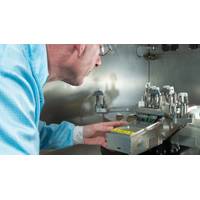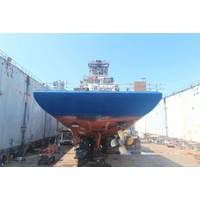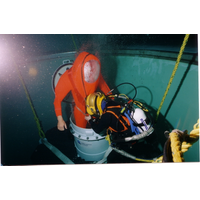
Silicon Sensing, Kongsberg Discovery Join Forces to Develop Gyro Technology
within each company. Kongsberg will use developments to enhance their next generation of high-performance systems—including Attitude and Heading Reference Systems (AHRS) and Inertial Navigation Systems (INS). Silicon Sensing will use these outcomes to benefit its precision Micro Electro-Mechanical Systems (MEMS) inertial measurement units (IMUs), gyros and accelerometers.The ambition for Silicon Sensing and Kongsberg Discovery is to achieve ‘navigation-grade’ performance from a MEMS-based gyro. Navigation-grade refers to a highly accurate and stable gyroscope used in inertial navigation
Silicon Sensing Establishes US Office
experience double-digit compound annual growth rate (CAGR) for inertial sensors through to 2030, alongside fast-evolving inertial requirements for a new generation of applications, the company said.“We expect our next generation of products, currently in development, to take micro-electro-mechanical systems (MEMS) inertial performance to new levels, redefining what this technology is capable of. This vital new presence in North America will ensure we are prepared with effective, responsive in-region support,” Somerville said.The new office will be situated in Lake Mary, Fla. and will support
Silicon Sensing’s Sales Rise 65% as it Hits 25th Anniversary
.“Our products are at the heart of many attitude and heading reference systems (AHRS) that are being used to map the seabed and to monitor the location of surface vessels,” said David Sommerville, General Manager, Silicon Sensing Systems.Silicon Sensing’s patented, micro electro-mechanical systems (MEMS) technology spans a range of inertial requirements, from single, silicon vibrating ring sensors to full 6 axis inertial measurement units (IMU’s).The latest inertial measurement unit, the DMU41, redefines the capabilities of MEMS technology, bringing high-performance sensing in

VideoRay Hires Holtz as Director of Product and Innovation
, expanding payloads, enhancing testing and quality control processes and optimizing new technologies for production, VideoRay said.Holtz served in the U.S. Navy as a Machinery Repairman Second Class (E-5). During that time, he supervised lathe and computer numerical control departments and repaired mechanical systems to support the Navy’s surface and subsurface fleet.Since his service with the Navy, Holtz has gone on to hold design engineering, product development, production processing, intervention engineering and managerial positions with a focus on underwater robotic systems, subsea technical

Silicon Sensing Appoints Dr. Marshall as Chief Engineer
design of the company’s latest generation, tactical grade inertial measurement unit (IMU) - the DMU41.“These are remarkable times in inertial sensing with a long held technological status quo now rapidly shifting," said Dr. Marshall. "A number of recent micro-electro-mechanical systems (MEMS) inertial product launches are truly challenging fiber-optic gyro (FOG) performance for the first time – with products that are much more compact and rugged - and less power consuming. One of these market disrupting products is our DMU41 9 degrees of freedom (DoF) IMU.”Before
Silicon Sensing Upgrades Gyro for Downhole Surveying
includes a move to a single board from two. This has reduced the unit’s mass by 40% and allows it to be installed far more easily in space-limited applications, such as the 25mm diameter cylinders typically used in downhole drilling equipment.CRS39A also incorporates upgraded micro electro-mechanical systems (MEMS) and electronics, including new drive electronics and improvements to the sensor head. These have delivered significant performance enhancements in critical areas such as bias instability, angle random walk, noise and vibration tolerance whilst multiple on-board temperature sensors allow

Interview: Tim Leach, Glosten, Discusses Efficient Refit by Design
improve function and reduce noise. This included:Upgrading HVAC controlsComputer lab server space HVACBow thruster room change from ventilation cooling to (AC) air conditioningModification of port and starboard Generator Room supply fan intakes to decrease noise and improve supply air qualityOther mechanical systems that are reaching the end of life were also replaced. Glosten developed requirements and design for:Chiller replacementNew refrigeration units for science and provisionsUncontaminated seawater (for science)PA replacementDial telephonesNew cranesThrough a parallel effort, Glosten developed a

Ransomware: The IT Danger on the Horizon
aggressive mode of attack?Over the last 10 years, the integration of operational technology (OT) and information technology (IT) systems in the maritime environment has accelerated dramatically. Onboard ships, modern network technologies allow for greater control and monitoring of engineering and mechanical systems, leading to increased reliability and efficiency for vessel operators. For ports and other infrastructure hubs, many key industrial systems now have physical connectivity with the outside world through integration with internal IT-based control systems. Autonomous cranes and driverless flatbed

JFD Partners with Innovation Maritime
depend on the circumstances. They may either be able to wait for rescue or, if the circumstances require it, to evacuate via an emergency escape system. The SET is a diving bell equipped with a replica submarine escape tower. This escape training module is moved vertically in a water column using mechanical systems which allows comprehensive training to be carried out in a perfectly controlled environment. Through this new partnership, JFD will be able to offer the SET solution, or variants, to customers thereby broadening its escape offering. JFD can also tailor its provisions to customers’ unique
 December 2025
December 2025





